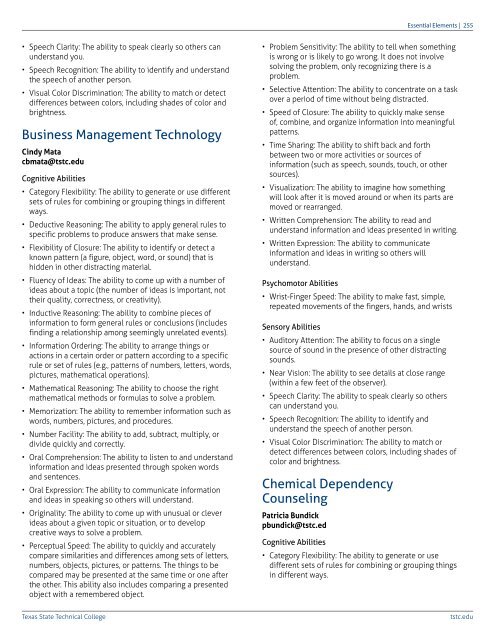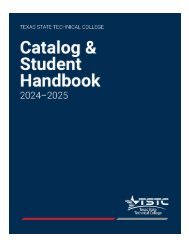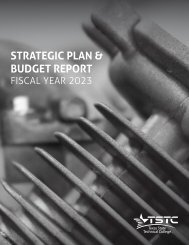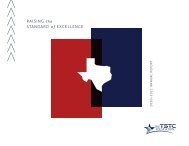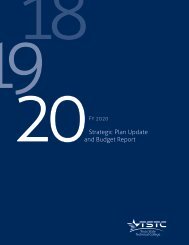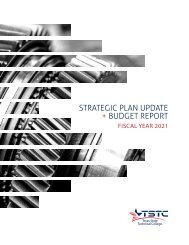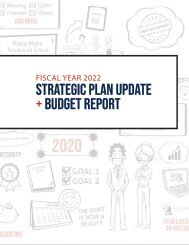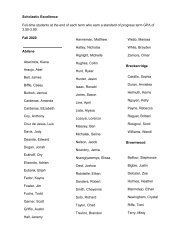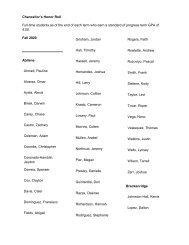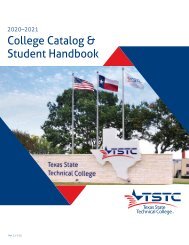Student Handbook and Catalog 2021-22 V2
Create successful ePaper yourself
Turn your PDF publications into a flip-book with our unique Google optimized e-Paper software.
Essential Elements | 255<br />
• Speech Clarity: The ability to speak clearly so others can<br />
underst<strong>and</strong> you.<br />
• Speech Recognition: The ability to identify <strong>and</strong> underst<strong>and</strong><br />
the speech of another person.<br />
• Visual Color Discrimination: The ability to match or detect<br />
differences between colors, including shades of color <strong>and</strong><br />
brightness.<br />
Business Management Technology<br />
Cindy Mata<br />
cbmata@tstc.edu<br />
Cognitive Abilities<br />
• Category Flexibility: The ability to generate or use different<br />
sets of rules for combining or grouping things in different<br />
ways.<br />
• Deductive Reasoning: The ability to apply general rules to<br />
specific problems to produce answers that make sense.<br />
• Flexibility of Closure: The ability to identify or detect a<br />
known pattern (a figure, object, word, or sound) that is<br />
hidden in other distracting material.<br />
• Fluency of Ideas: The ability to come up with a number of<br />
ideas about a topic (the number of ideas is important, not<br />
their quality, correctness, or creativity).<br />
• Inductive Reasoning: The ability to combine pieces of<br />
information to form general rules or conclusions (includes<br />
finding a relationship among seemingly unrelated events).<br />
• Information Ordering: The ability to arrange things or<br />
actions in a certain order or pattern according to a specific<br />
rule or set of rules (e.g., patterns of numbers, letters, words,<br />
pictures, mathematical operations).<br />
• Mathematical Reasoning: The ability to choose the right<br />
mathematical methods or formulas to solve a problem.<br />
• Memorization: The ability to remember information such as<br />
words, numbers, pictures, <strong>and</strong> procedures.<br />
• Number Facility: The ability to add, subtract, multiply, or<br />
divide quickly <strong>and</strong> correctly.<br />
• Oral Comprehension: The ability to listen to <strong>and</strong> underst<strong>and</strong><br />
information <strong>and</strong> ideas presented through spoken words<br />
<strong>and</strong> sentences.<br />
• Oral Expression: The ability to communicate information<br />
<strong>and</strong> ideas in speaking so others will underst<strong>and</strong>.<br />
• Originality: The ability to come up with unusual or clever<br />
ideas about a given topic or situation, or to develop<br />
creative ways to solve a problem.<br />
• Perceptual Speed: The ability to quickly <strong>and</strong> accurately<br />
compare similarities <strong>and</strong> differences among sets of letters,<br />
numbers, objects, pictures, or patterns. The things to be<br />
compared may be presented at the same time or one after<br />
the other. This ability also includes comparing a presented<br />
object with a remembered object.<br />
• Problem Sensitivity: The ability to tell when something<br />
is wrong or is likely to go wrong. It does not involve<br />
solving the problem, only recognizing there is a<br />
problem.<br />
• Selective Attention: The ability to concentrate on a task<br />
over a period of time without being distracted.<br />
• Speed of Closure: The ability to quickly make sense<br />
of, combine, <strong>and</strong> organize information into meaningful<br />
patterns.<br />
• Time Sharing: The ability to shift back <strong>and</strong> forth<br />
between two or more activities or sources of<br />
information (such as speech, sounds, touch, or other<br />
sources).<br />
• Visualization: The ability to imagine how something<br />
will look after it is moved around or when its parts are<br />
moved or rearranged.<br />
• Written Comprehension: The ability to read <strong>and</strong><br />
underst<strong>and</strong> information <strong>and</strong> ideas presented in writing.<br />
• Written Expression: The ability to communicate<br />
information <strong>and</strong> ideas in writing so others will<br />
underst<strong>and</strong>.<br />
Psychomotor Abilities<br />
• Wrist-Finger Speed: The ability to make fast, simple,<br />
repeated movements of the fingers, h<strong>and</strong>s, <strong>and</strong> wrists<br />
Sensory Abilities<br />
• Auditory Attention: The ability to focus on a single<br />
source of sound in the presence of other distracting<br />
sounds.<br />
• Near Vision: The ability to see details at close range<br />
(within a few feet of the observer).<br />
• Speech Clarity: The ability to speak clearly so others<br />
can underst<strong>and</strong> you.<br />
• Speech Recognition: The ability to identify <strong>and</strong><br />
underst<strong>and</strong> the speech of another person.<br />
• Visual Color Discrimination: The ability to match or<br />
detect differences between colors, including shades of<br />
color <strong>and</strong> brightness.<br />
Chemical Dependency<br />
Counseling<br />
Patricia Bundick<br />
pbundick@tstc.ed<br />
Cognitive Abilities<br />
• Category Flexibility: The ability to generate or use<br />
different sets of rules for combining or grouping things<br />
in different ways.<br />
Texas State Technical College<br />
tstc.edu


